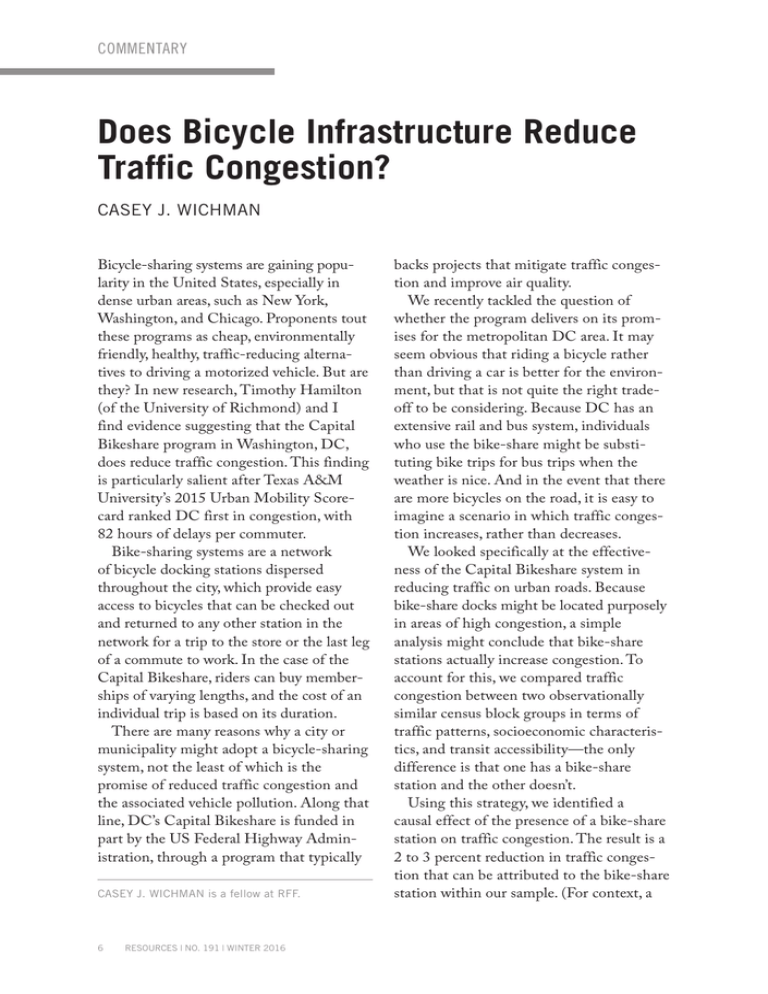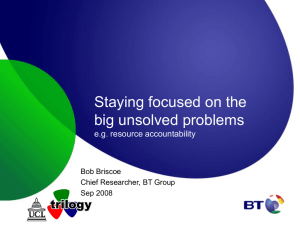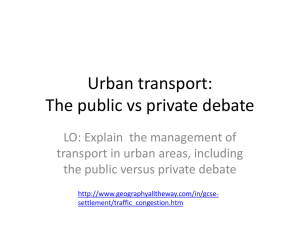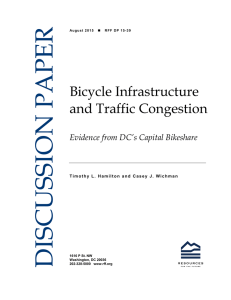Does Bicycle Infrastructure Reduce Traffic Congestion? CASEY J. WICHMAN
advertisement

COMMENTARY Does Bicycle Infrastructure Reduce Traffic Congestion? CASEY J. WICHMAN Bicycle-sharing systems are gaining popularity in the United States, especially in dense urban areas, such as New York, Washington, and Chicago. Proponents tout these programs as cheap, environmentally friendly, healthy, traffic-reducing alternatives to driving a motorized vehicle. But are they? In new research, Timothy Hamilton (of the University of Richmond) and I find evidence suggesting that the Capital Bikeshare program in Washington, DC, does reduce traffic congestion. This finding is particularly salient after Texas A&M University’s 2015 Urban Mobility Scorecard ranked DC first in congestion, with 82 hours of delays per commuter. Bike-sharing systems are a network of bicycle docking stations dispersed throughout the city, which provide easy access to bicycles that can be checked out and returned to any other station in the network for a trip to the store or the last leg of a commute to work. In the case of the Capital Bikeshare, riders can buy memberships of varying lengths, and the cost of an individual trip is based on its duration. There are many reasons why a city or municipality might adopt a bicycle-sharing system, not the least of which is the promise of reduced traffic congestion and the associated vehicle pollution. Along that line, DC’s Capital Bikeshare is funded in part by the US Federal Highway Administration, through a program that typically CASEY J. WICHMAN is a fellow at RFF. 6 RESOURCES | NO. 191 | WINTER 2016 backs projects that mitigate traffic congestion and improve air quality. We recently tackled the question of whether the program delivers on its promises for the metropolitan DC area. It may seem obvious that riding a bicycle rather than driving a car is better for the environment, but that is not quite the right tradeoff to be considering. Because DC has an extensive rail and bus system, individuals who use the bike-share might be substituting bike trips for bus trips when the weather is nice. And in the event that there are more bicycles on the road, it is easy to imagine a scenario in which traffic congestion increases, rather than decreases. We looked specifically at the effectiveness of the Capital Bikeshare system in reducing traffic on urban roads. Because bike-share docks might be located purposely in areas of high congestion, a simple analysis might conclude that bike-share stations actually increase congestion. To account for this, we compared traffic congestion between two observationally similar census block groups in terms of traffic patterns, socioeconomic characteristics, and transit accessibility—the only difference is that one has a bike-share station and the other doesn’t. Using this strategy, we identified a causal effect of the presence of a bike-share station on traffic congestion. The result is a 2 to 3 percent reduction in traffic congestion that can be attributed to the bike-share station within our sample. (For context, a © Mr.TinDC/Flickr COMMENTARY 1 percent reduction in congestion results in a roughly 1 percent increase in vehicle miles per hour driven for a representative road segment in our sample.) A secondary finding, although only suggestive, is that congestion increases in census block groups neighboring those with bike-share stations. This result is a bit more puzzling. It could be the case that motor vehicle drivers seek to avoid streets populated with cyclists. Further, it could be that the cyclist rides through neighboring census blocks on her way to work, thus contributing to congestion increases there. Looking forward, this research lays a foundation for exploring a suite of questions related to the impact of bicycling on traffic patterns in urban areas. The degree of complementarity or substitutability of cycling for other modes of transit dictates the degree to which we can stretch transportation funding in an economic climate where investment in infrastructure is critical. At a minimum, however, our research findings suggest that there are environmental benefits embedded somewhere in each Capital Bikeshare bicycle. And with a $2.5 million expansion and an additional 435 bicycles planned for the Capital Bikeshare in the District, the interactions among bicycle infrastructure and other modes of transit are only going to become more relevant. · This article originally appeared on RFF’s blog, Common Resources (www.rff.org/blog). FURTHER READING Hamilton, Timothy, and Casey J. Wichman. 2015. Bicycle Infrastructure and Traffic Congestion: Evidence from DC’s Capital Bikeshare. Discussion paper 15-39. Washington, DC: RFF. WWW.RFF.ORG/RESOURCES 7




